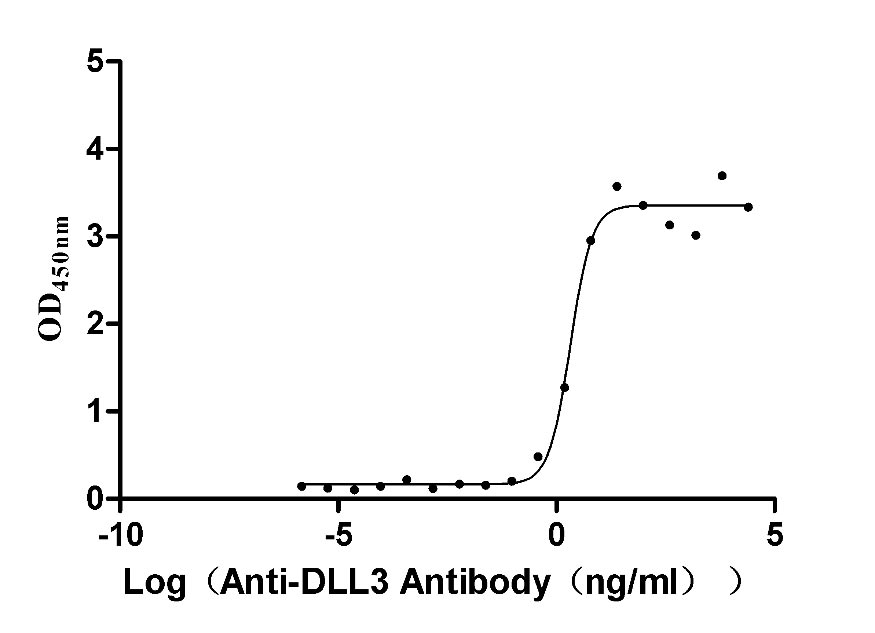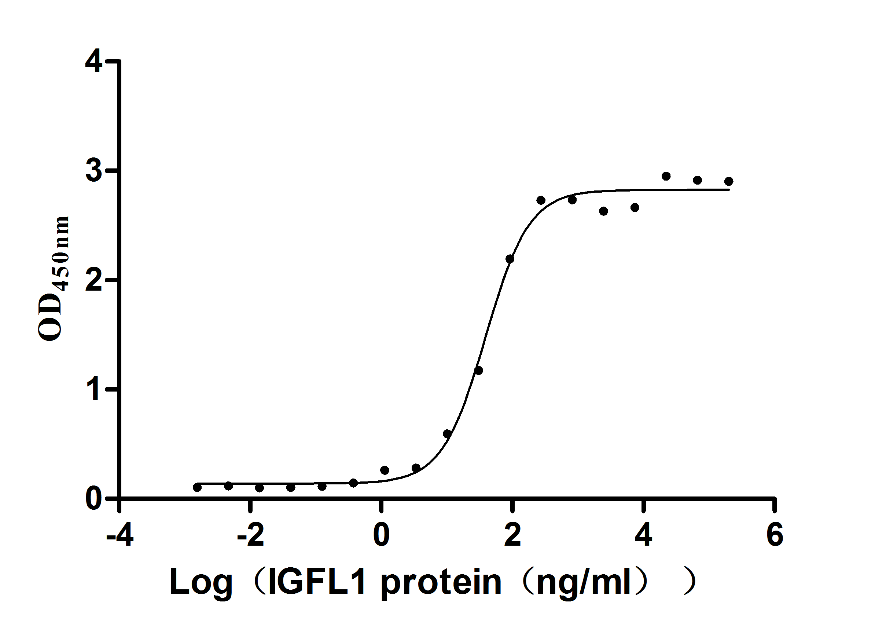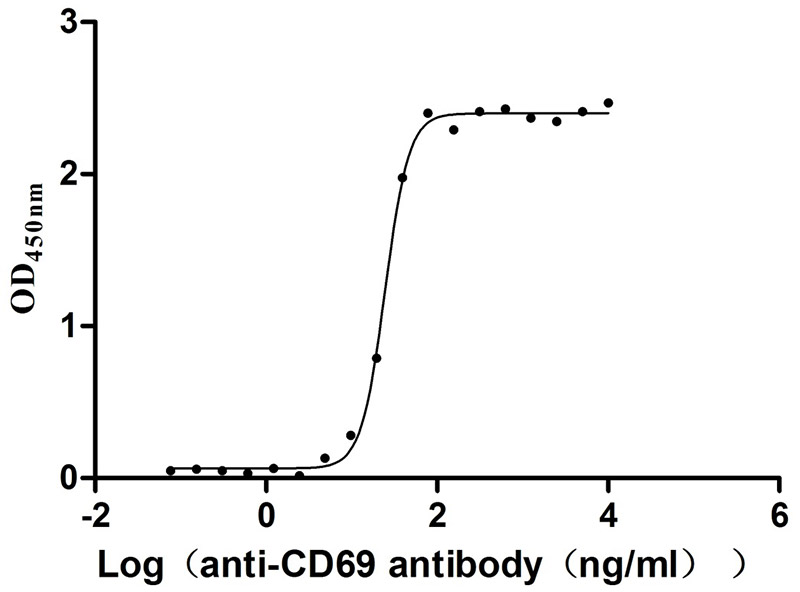Recombinant Rat Beta-1 adrenergic receptor (Adrb1), partial
-
中文名称:Recombinant Rat Beta-1 adrenergic receptor(Adrb1),partial,Yeast
-
货号:CSB-YP001391RA1
-
规格:
-
来源:Yeast
-
其他:
-
中文名称:Recombinant Rat Beta-1 adrenergic receptor(Adrb1),partial,Yeast
-
货号:CSB-EP001391RA1
-
规格:
-
来源:E.coli
-
其他:
-
中文名称:Recombinant Rat Beta-1 adrenergic receptor(Adrb1),partial,Yeast
-
货号:CSB-EP001391RA1-B
-
规格:
-
来源:E.coli
-
共轭:Avi-tag Biotinylated
E. coli biotin ligase (BirA) is highly specific in covalently attaching biotin to the 15 amino acid AviTag peptide. This recombinant protein was biotinylated in vivo by AviTag-BirA technology, which method is BriA catalyzes amide linkage between the biotin and the specific lysine of the AviTag.
-
其他:
-
中文名称:Recombinant Rat Beta-1 adrenergic receptor(Adrb1),partial,Yeast
-
货号:CSB-BP001391RA1
-
规格:
-
来源:Baculovirus
-
其他:
-
中文名称:Recombinant Rat Beta-1 adrenergic receptor(Adrb1),partial,Yeast
-
货号:CSB-MP001391RA1
-
规格:
-
来源:Mammalian cell
-
其他:
产品详情
-
纯度:>85% (SDS-PAGE)
-
基因名:
-
Uniprot No.:
-
别名:Adrb1; Adrb1r; Beta-1 adrenergic receptor; Beta-1 adrenoreceptor; Beta-1 adrenoceptor
-
种属:Rattus norvegicus (Rat)
-
蛋白长度:Partial
-
蛋白标签:Tag type will be determined during the manufacturing process.
The tag type will be determined during production process. If you have specified tag type, please tell us and we will develop the specified tag preferentially. -
产品提供形式:Lyophilized powder
Note: We will preferentially ship the format that we have in stock, however, if you have any special requirement for the format, please remark your requirement when placing the order, we will prepare according to your demand. -
复溶:We recommend that this vial be briefly centrifuged prior to opening to bring the contents to the bottom. Please reconstitute protein in deionized sterile water to a concentration of 0.1-1.0 mg/mL.We recommend to add 5-50% of glycerol (final concentration) and aliquot for long-term storage at -20℃/-80℃. Our default final concentration of glycerol is 50%. Customers could use it as reference.
-
储存条件:Store at -20°C/-80°C upon receipt, aliquoting is necessary for mutiple use. Avoid repeated freeze-thaw cycles.
-
保质期:The shelf life is related to many factors, storage state, buffer ingredients, storage temperature and the stability of the protein itself.
Generally, the shelf life of liquid form is 6 months at -20°C/-80°C. The shelf life of lyophilized form is 12 months at -20°C/-80°C. -
货期:Delivery time may differ from different purchasing way or location, please kindly consult your local distributors for specific delivery time.Note: All of our proteins are default shipped with normal blue ice packs, if you request to ship with dry ice, please communicate with us in advance and extra fees will be charged.
-
注意事项:Repeated freezing and thawing is not recommended. Store working aliquots at 4°C for up to one week.
-
Datasheet :Please contact us to get it.
相关产品
靶点详情
-
功能:Beta-adrenergic receptors mediate the catecholamine-induced activation of adenylate cyclase through the action of G proteins. This receptor binds epinephrine and norepinephrine with approximately equal affinity. Mediates Ras activation through G(s)-alpha- and cAMP-mediated signaling. Involved in the regulation of sleep/wake behaviors.
-
基因功能参考文献:
- beta-AR stimulation affects post-translational modifications of NF2 via the involvement beta1-AR/PKA/cAMP pathway, and NF2 plays a pro-apoptotic role in beta-AR-stimulated myocyte apoptosis via the phosphorylation (inactivation) of YAP and involvement of mitochondrial death pathway PMID: 29709009
- Proliferation in cardiac fibroblasts induced by beta1-adrenoceptor autoantibody results in endomyocardial fibrosis. PMID: 27577254
- Let-7a regulates beta1-AR expression and forms a negative feedback loop with beta1-AR signaling pathway in ischemic heart failure PMID: 28060734
- beta-AR stimulation induces HDAC5 nuclear accumulation in cardiomyocytes by a mechanism that is protein kinase A-dependent but requires B55alpha-PP2A-mediated dephosphorylation of Ser259/Ser498. PMID: 28343149
- Using a GalNAc-T2 knock-out rat model, this study shows that GalNAc-T2 co-regulates the metalloproteinase-mediated limited proteolysis of B1AR. PMID: 28167537
- Suggest a common regulatory pattern for the beta(1)-AR/GRK5 which is independent of cellular type or pathology. PMID: 26248277
- Data show that beta1-Adrenoceptor stimulation triggers the production of the second messenger cAMP, which activates the Rap guanine nucleotide exchange factor Epac and the protein kinase A (PKA). PMID: 26462734
- Chronic bilateral renal denervation reduces cardiac hypertrophic remodelling but not beta-adrenergic responsiveness in hypertensive type 1 diabetic rats. PMID: 25881071
- These findings suggest that PSD95 mediates a vasodilator complex with beta1AR and KV1 channels in cVSMCs PMID: 25966954
- Results show that beta1-ARs-mediated Nrf2-HO-1-HMGB1 axis regulation plays a critical protective role in H/R-induced neonatal rat cardiomyocytes injury in vitro via PI3K/p38MAPK signaling pathway. PMID: 25634756
- these data indicate that beta1AR agonist treatment during disuse mitigates negative changes in cancellous bone microarchitecture and inhibits increases in osteocyte apoptosis PMID: 25211027
- The possible role of medial prefrontal cortex beta-1-adrenoceptors in morphine-induced amnesia PMID: 25096537
- The aptamer's potential for beta1(II)-AAB neutralization and consequently for cardiomyopathy treatment has been shown for the first time in vivo. PMID: 24744110
- Despite all three Adrb subtypes being found in both vessels, Adrb1, located in smooth muscle cells and acting through the adenylyl cyclase/cAMP pathway, are primarily responsible for vasodilatation in mesenteric resistance artery PMID: 23373597
- Data suggest activation of endothelial Adrb1 (beta-1-adrenoceptors) suppresses vasodilation and this is mediated through inhibition of endothelial Kcnn4 (intermediate conductance Ca-activated K channels) depressing endothelial cell hyperpolarization. PMID: 23488860
- A set of miRNAs is differently expressed in the aorta of high salt treated rats with miR-320 increased and miR-26b and -21 decreased, through beta1 and beta3-adrenoreceptor pathways. PMID: 24161401
- During the period of sleep deprivation, mRNA levels of adrenergic beta 1 receptors were reduced in frontal cortex. PMID: 23916734
- The data establish a prominent role for PDZ2 and I3 domains of SAP97 in organizing the ss1-adrenergic receptosome involved in connecting the ss1-AR to trafficking and signaling networks. PMID: 23696820
- We demonstrate that restoration of cardiac plasma membrane levels of S1PR1 produces beneficial effects that counterbalance the deleterious beta1AR overstimulation in heart failure. PMID: 23969695
- Up-regulation of beta1AR action was eliminated with 17beta-estradiol addition to the media, directly implicating this hormone as a regulator of beta1AR expression. PMID: 23533220
- Overexpression of beta(1)-AR has no significant protective effect on rat cardiomyocytes injured by isoprenaline. PMID: 21170495
- Both alpha1- and beta1-adrenoceptors in the bed nucleus of the stria terminalis are involved in the expression of conditioned contextual fear PMID: 22506532
- Data show that beta(1)-AR stimulation in response to aorto-caval fistula induces FA signaling downregulation through an ECM-independent mechanism. PMID: 22609523
- Thus, beta-AR stimulation induces ER stress in cardiac myocytes and in the heart, and induction of ER stress plays a pro-apoptotic role PMID: 22270541
- the site of action of beta1 receptor activation is most likely on the presynaptic nerve terminals surrounding cardiac vagal neurons PMID: 22425752
- Spleen T cells were more vulnerable to stress compared to B cells, because of increased beta-, beta- and beta-adrenoceptors after a single immobilization. PMID: 22248722
- beta(1)-AR and 5-HT(4) receptor signalling are subject to opposite regulatory control by cGMP generated by soluble guanylyl cyclase in failing hearts. PMID: 21901315
- Stress did not alter Adrb1 expression in heart ventricles. PMID: 21777029
- Methylation of adrenergic beta1 receptor is a potential epigenetic mechanism controlling antihypertensive response to metoprolol PMID: 22165287
- results provide further evidence that autoantibody against beta1-AR-extracellular loop is involved in the pathogenesis of heart failure PMID: 20096470
- Exercise training did not blunt the diabetes-induced decrease of cardiac beta1-adrenoceptor protein expression. PMID: 21054861
- Our results reinforce the role of the ventromedial prefronal cortex in fear extinction mechanisms, suggesting that ventromedial prefrontal cortex-beta-1-adrenergic receptor activation underlies part of the facilitation of the fear extinction processes. PMID: 20667477
- An NPR-B-cGMP-PDE3 inhibitory pathway enhances beta(1)-AR-mediated responses and may in the long term be detrimental to the failing heart PMID: 19900965
- Substance P could down-regulate the expression of beta1-AR in cultured rat cardiomyocytes in vitro. PMID: 19111114
- Beta(1)-Adrenergic receptor, confined to the plasma membrane, increased phosphatidylserine translocation and apoptosis. PMID: 19932173
- regulation of cardiac beta(1)AR transcription and the expression of c-myc are tightly integrated PMID: 12742828
- Noradrenaline depolarizes striatal cholinergic interneurons via beta1-adrenoceptor activation, through a cAMP-dependent but PKA-independent mechanism PMID: 12832552
- In cardiac myocytes, beta1AR stimulation activates dual signaling pathways mediated by cAMP/PKA and CaMKII, the former undergoing desensitization and the latter exhibiting sensitization. PMID: 15375008
- Beta1-AR stimulation activates PI3K via PKA, G(betagamma) & betaARK1. This negates cAMP-induced positive inotropism by inhibiting sarcolemmal Ca2+ influx & the subsequent increase in intracellular Ca2+ transients in intact cardiomyocytes. PMID: 15539636
- beta1-AR stimulation resulted in a greater magnitude and rate of onset of inotropic and MVO2 responses than did beta2-AR but, a similar decrease in intracellular energy charge was seen in the two groups during beta1- than during beta2-AR stimulation. PMID: 15840637
- correlate phosphorylation of S1928 with beta1-adrenergic functional up-regulation of cardiac calcium channels in the presence of 1,2-bis(2-aminophenoxy)ethane-N',N'-tetraacetic acid in intact ventricular myocytes PMID: 17053072
- Almost all of the neuronal nuclei positive cells express beta1-adrenergic receptor while few glial fibrillary acidic protein positive cells express them. Interestingly, beta1-ARs are predominantly distributed in the cell membrane and cytoplasm. PMID: 17337326
- Beta(1)-ARs were immunolocalized to sites overlapping apical and basal poles of the inner and outer hair cells, in Hensen's and Deiters' cells would couple to Galphas, known to be present specifically in the supporting cells. PMID: 17671986
- These findings suggest that in the myocardium the regulated expression of EMMPRIN is a determinant of MMP activity and may thus play a role in myocardial remodeling. PMID: 17869266
- The results suggested that beta(1)-AR might be critical for the retrieval of auditory fear memory. PMID: 17961922
- Partial left ventricular unloading regressed myocardial hypertrophy, reversed contractile dysfunction and normalized the mRNA beta(1)-adrenergic receptors expression of failing rat hearts. PMID: 18006556
- Endocytosis machinery is required for beta1-adrenergic receptor-induced hypertrophy in neonatal rat cardiac myocytes. PMID: 18194989
- Beta1-adrenoceptor expression in rat anterior pituitary gonadotrophs. PMID: 18202120
- beta(1)-AR significantly contributes to basal adenylate cyclase activity in the pituitary. PMID: 18202135
- Labetalol-induced inhibition of PAG cell firing is due to its potentiation of GABAergic transmission. Labetalol-induced analgesia is due to its antagonistic effects on presynaptic beta1-adrenoceptors. PMID: 18262504
显示更多
收起更多
-
亚细胞定位:Cell membrane; Multi-pass membrane protein. Early endosome.
-
蛋白家族:G-protein coupled receptor 1 family, Adrenergic receptor subfamily, ADRB1 sub-subfamily
-
组织特异性:Expressed in cortical neurons and coronary artery smooth muscle cells (at protein level).
-
数据库链接:
KEGG: rno:24925
STRING: 10116.ENSRNOP00000022813
UniGene: Rn.87064
Most popular with customers
-
Recombinant Macaca fascicularis Delta-like protein 3 (DLL3), partial (Active)
Express system: Mammalian cell
Species: Macaca fascicularis (Crab-eating macaque) (Cynomolgus monkey)
-
Recombinant Human IGF-like family receptor 1 (IGFLR1), partial (Active)
Express system: Mammalian cell
Species: Homo sapiens (Human)
-
Recombinant Human Claudin-18.2 (CLDN18.2)-VLPs (Active)
Express system: Mammalian cell
Species: Homo sapiens (Human)
-
Recombinant Mouse Tyrosine-protein kinase Mer (Mertk), partial (Active)
Express system: Mammalian cell
Species: Mus musculus (Mouse)
-
Recombinant Human Early activation antigen CD69 (CD69), partial (Active)
Express system: Mammalian cell
Species: Homo sapiens (Human)
-
Recombinant Human C-C chemokine receptor type 6(CCR6)-VLPs (Active)
Express system: Mammalian cell
Species: Homo sapiens (Human)
-
Recombinant Human Gastric inhibitory polypeptide receptor(GIPR),partial (Active)
Express system: Mammalian cell
Species: Homo sapiens (Human)
-
Recombinant Human Kidney-associated antigen 1(KAAG1) (Active)
Express system: Baculovirus
Species: Homo sapiens (Human)




-AC1.jpg)















